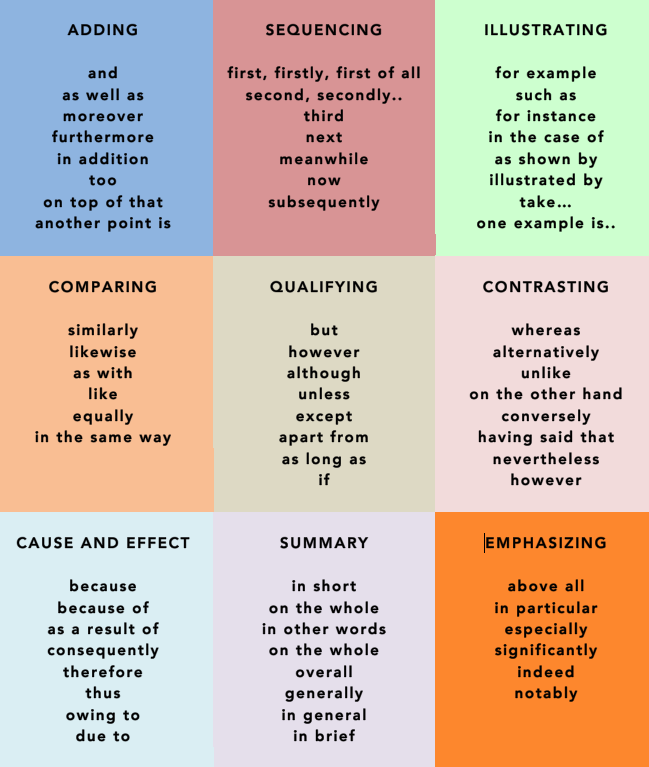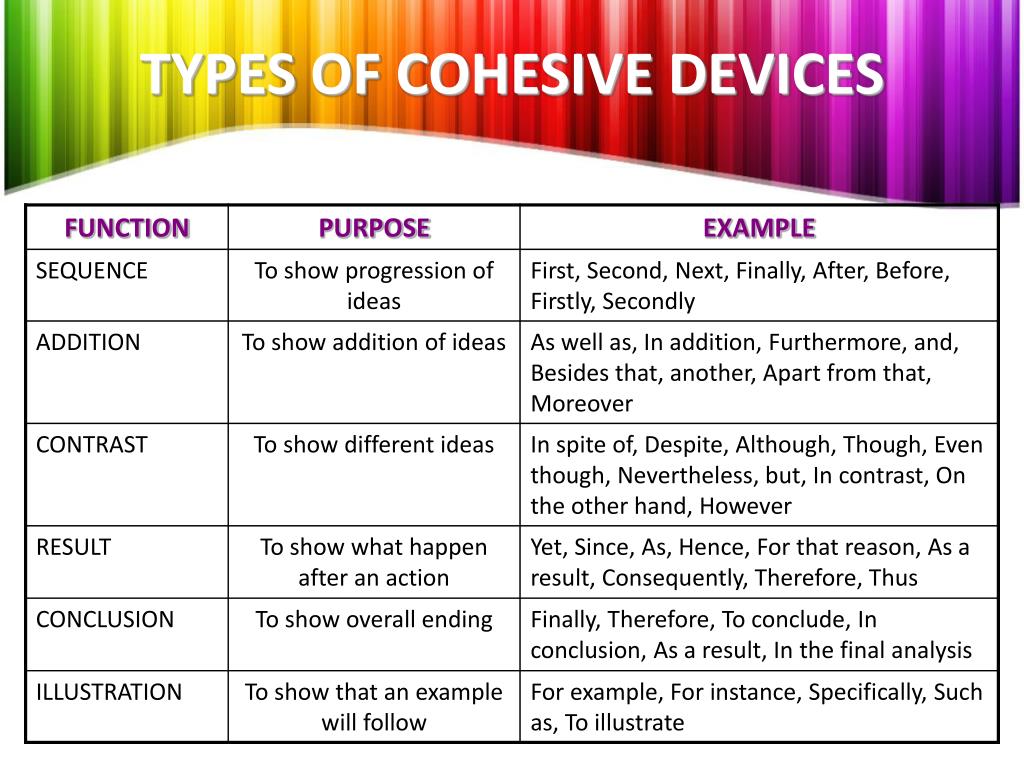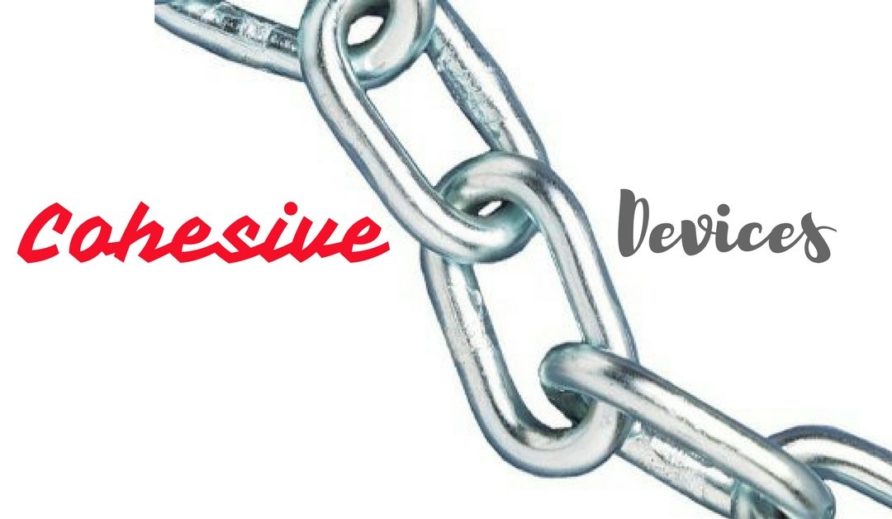
76 best Vocabulary images on Pinterest English grammar, English class and English language
October 25, 2023. Cohesive devices are sometimes called linking words, linkers, connectors, discourse markers, or transitional words. Cohesive Devices are words or phrases that show the relationship between paragraphs or sections of a text or speech. Cohesive devices are words like ' For example, ' In conclusion, ' however ' and.

Cohesive Devices TED IELTS
Cohesive Writing Connects Topic and Stress: Sentences are cohesive when the stress of one sentence is used as the topic of the next. Below, the first example reads like a list of facts. The ideas are related but the sentences don't connect. The second example connects the topics and stress which creates a sense of flow.

How To Use Cohesive Devices — IELTS ACHIEVE
When we talk about conjunction as a cohesive device, we mean ways to relate two clauses, sentences, or paragraphs together into a functional relationship. The relationship can be additive, adversative, causal, or temporal. For example, one clause may be the reason for the other: He finished the pizza because he was hungry.

A lot of you asked for the infographic on cohesive devices from today's Facebook lesson. So I
Basically, when a person's writing has cohesion, an attempt has been made to link clauses, sentences and paragraphs so that the writing 'hangs together'. This piece of writing shows how cohesive devices can be used: The time connectives (in red: first, then, later, after, finally) are used to show that this is a process that has several steps.

Essay cohesive devices grammar
Cohesive devices, sometimes called linking words, linkers, connectors, discourse markers or transitional words, are one of the most misunderstood and misused parts of IELTS Writing. Cohesive devices are words like ' For example ', ' In conclusion ', ' however ' and ' moreover '. Together with coherence, cohesion provides 25% of.

Pin by Zaidee Kalila on English grammar Writing tips, Study tips, English grammar
Cohesive devices are essential linguistic tools that ensure smooth transitions and logical connections within writing. Categorized by their functions, these devices, such as those indicating agreement, contradiction, cause and effect, examples, or time and space relationships, contribute significantly to a text's structure and clarity.

Cohesive devices Como aprender ingles basico, Vocabulario en ingles, Aprender ingles en casa
Cohesive devices, also known as transition words or linking expressions, act as signposting language for your reader and let them know what is coming next. For example, ' and ' signals that you are going to make an additional point, whereas ' but ' signposts a contrasting idea. You can use cohesive devices to link ideas within a.

Cohesive devices
When you want to provide examples or evidence to support your statements in writing, cohesive devices help connect your ideas and make your argument more persuasive. Here are examples of cohesive devices for giving examples or evidence: 1. For example: Many fruits are rich in vitamins; for example, oranges are high in vitamin C. 2. For instance:

cohesivedevicesielts1 Langports
Learn how and when to use cohesive devices like determiners, pronouns, conjunctions and adverbs. Perfect to help with grammar homework and to prepare for the.

PPT ACADEMIC ENGLISH [UWB 10102] PowerPoint Presentation, free download ID7063805
To its credit, Halliday and Hasan ( 1976) model in textual analysis has been considered the most comprehensive account of cohesive devices (Moreno 2003; Xi 2010 ). Chen ( 2008) adds that the model provides a well-developed taxonomy of cohesion. In accord with these views, Baker ( 2011) argues that the 1976 model is "the best known and most.
How to Use Cohesive Devices Correctly [for IELTS Writing] TED IELTS
Cohesive devices are also known as transitional words, connectors, or linking words. Cohesive devices are words, phrases, or techniques used to connect ideas and create coherence in writing. They.

English Cohesive device or Linking words Exercises Douczer
Types of Cohesive Devices. Pronoun: Referring back to a person or object already named without having to repeat it. Example. Jim closely followed his wife.. Prepositions: Shows relationships between noun and rest of the sentence. Example: Alex will come home from vacation on Saturday.. Conjunctions: words like or, and, but, so are used within the sentence to join sentences and phrases.

Cohesive devices in IELTS, coherence and cohesion
Cohesive devices are words or phrases that help to connect your ideas and make your writing more coherent and logical. They are also known as linking words, connectors, or discourse markers. They show the relationship between sentences, paragraphs, or sections of a text or speech. Using cohesive devices effectively can improve your writing.

The Cohesive Devices IELTS Writing Swoosh English
Cohesive devices. When we read a piece of writing, we need to pay attention to how the various sentences are related to each other. Sometimes this relationship is apparent through the logical development of ideas. Sometimes it is clear from the use of pronouns or the repetition of words or the use of synonyms.

Cohesive devices in IELTS, coherence and cohesion
Cohesive Device Examples. Finally, let's look at a list of cohesive devices, divided by type. This is not an exhaustive list, of course. It is just a small sample of the vast array of cohesive devices that exist. However, maybe you will find it useful. Conjunctive adverbs: Subordinating conjunctions:

Cohesive Devices Poster Set Teacher Resources and Classroom Games Teach This
Cohesive devices are words or phrases used to connect ideas between different parts of text. There are three main types of cohesive devices: Pronouns that refer back to a previously mentioned noun. Example: Jim went out to the playground. He played on the swings. Substitution of a synonym for a previously mentioned noun.